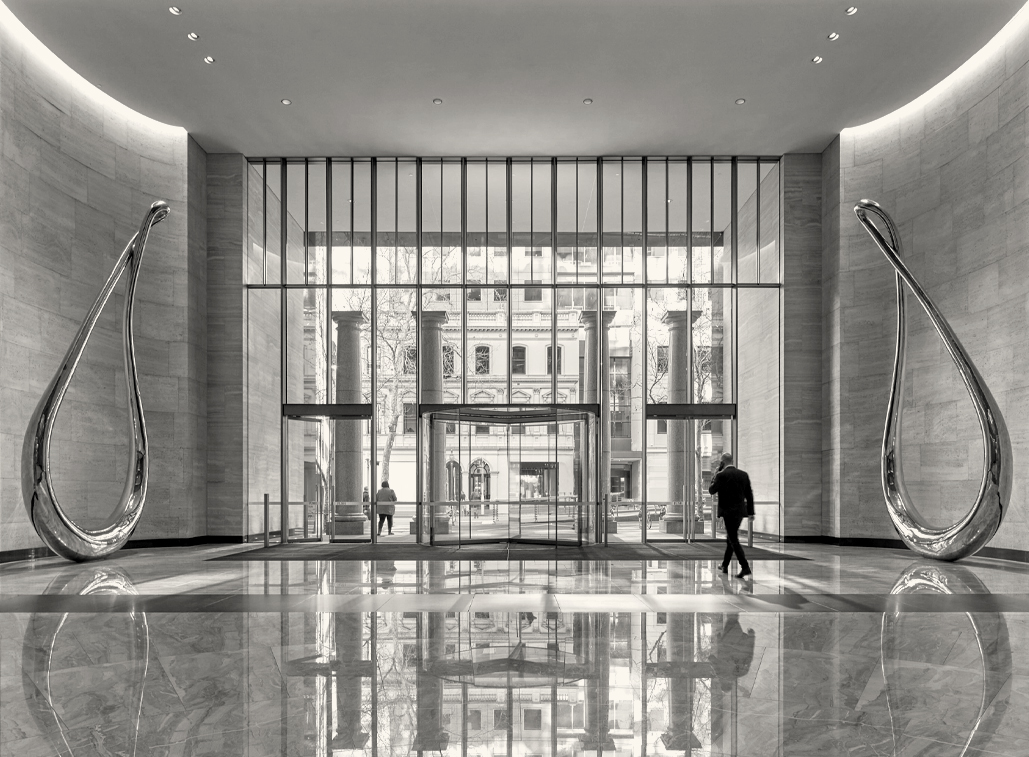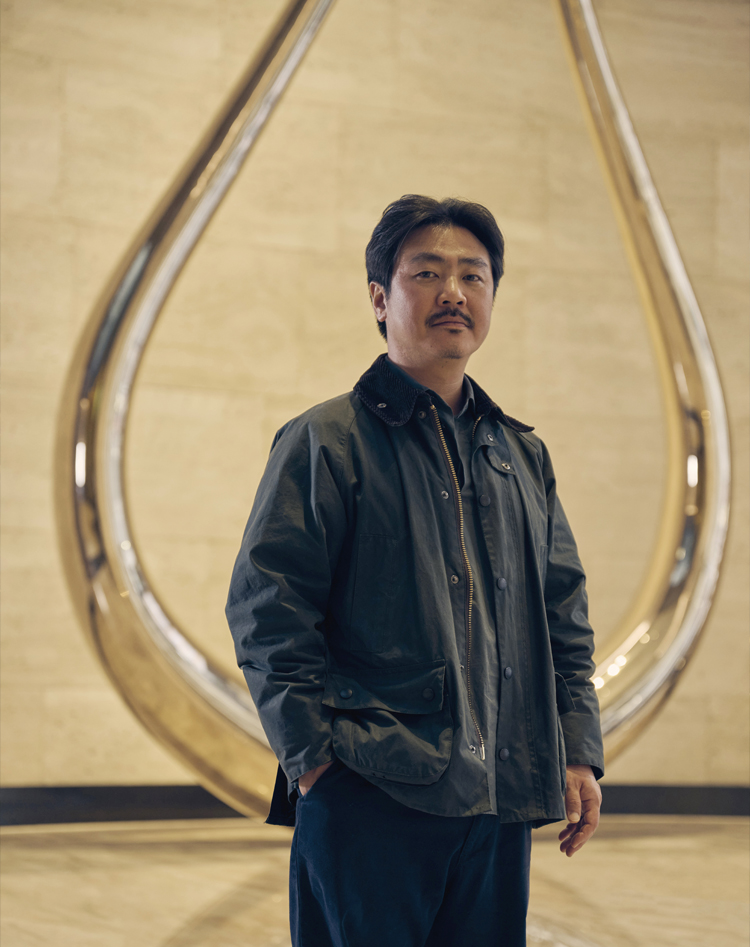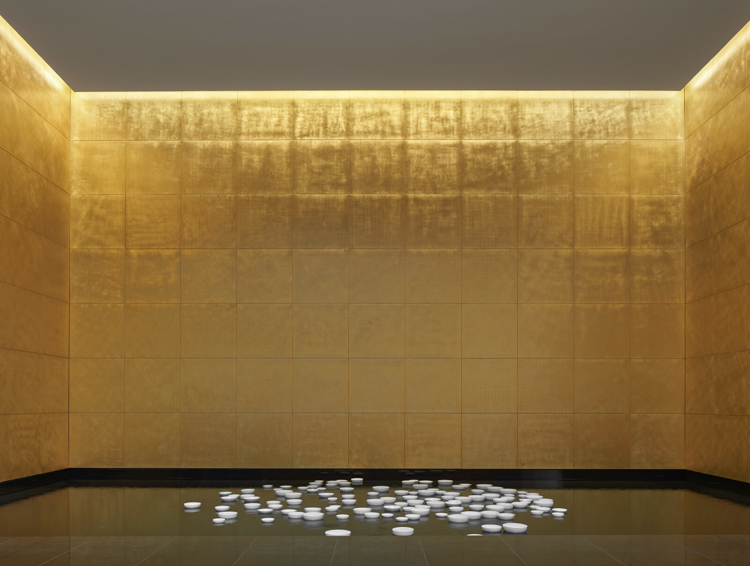
Transgressing corporate codes, they invite people to stop, shed the more mundane aspects of their day-to-day life and connect to their mind and bodies. Together, they embody innovation in thinking, engineering, scale, light and sound, creating an almost transcendental experience.
“I want people to be very aware of their bodies and of the extraordinary nature of these spaces,” says curator Emily Cormack. “Understanding that once we wake up the body and our senses, then our workday can operate in an entirely new way. These artworks offer visitors the opportunity to activate another part of themselves that they don’t often get to exercise, where they’re thinking about their body and how it moves through the everyday in a different way. The works will definitely give people time to pause for thought.”The three new permanent artworks on the Ground Floor of 101 Collins Street break all the rules of what you’re supposed to do in lobbies. Transgressing corporate codes, they invite people to stop, shed the more mundane aspects of their day-to-day life and connect to their mind and bodies. Together, they embody innovation in thinking, engineering, scale, light and sound, creating an almost transcendental experience.

The experience begins at the Collins Street entrance. Revitalised as part of 101 Collins’ Ground Floor Evolution by architects Bates Smart, the exfoliated black granite floor and specialist lighting treatment create a dramatic entry. It’s here, in the entry niches, that we encounter Orbit – two large-scale sculptures by Korean-born, New Zealand-based artist Seung Yul Oh. Known for his whimsical works that play with scale and explore both spectacle and participation, Oh has created a pair of 6.5m high mirror-polish bronze infinity symbols, which cantilever over the entrance space.
Interested in redefining ordinary spaces and objects in both lighthearted and serious ways, Oh’s work articulates the central ceiling space, highlighting its grand vastness, whilst the work’s cantilevered curvature seems to embrace the viewer. According to Oh, “The form of the sculpture suggests grace, momentum and continuous action, mimicking an altered orbital pattern that one object might take around another. Binding together the left and right entrance niches in one continuous pattern.”
“I wanted to emphasise the cycle of flow as an important aspect in our daily lives,” he says. “Activity is both levitating and grounding, it comes and goes, it loops. I want people to feel something familiar but at the same time unfamiliar, something old but also new, something seen but unseen.”
Coated in lush liquid mirror polish, Orbit captures and mimics the movement of people in the space, embracing the viewer in a nurturing but also comic and slightly unnerving way. The sculpture at once reflects the bodies of the viewers while they simultaneously dematerialise and become part of it.
When determining what sort of artworks would suit the different areas of the new Ground Floor, curator Emily Cormack divided the spaces into zones. “The entrance piece needed to articulate the entrance experience thoughtfully while responding to the key themes of transparency, immersion, reflection and liquid”, says Emily. “Seung’s work thinks through the entire space, successfully responding to all these ideas and, despite their luxurious materiality, they’re not intimidating or grandiose, they’re actually incredibly disarming.”
Further inside the building, the gold reflecting pools sit in two spectacular voids on the left and right-hand sides of the Collins Street entrance. You’d be pushed to find a more beautiful and resonant gallery space in the entire city, or a more perfect artwork to fill it. duplex (2021) by the French artist Céleste Boursier-Mougenot is a visual and acoustic installation where, in the right-hand pool, a perspex circle submerged in the water contains over 80 floating circular ceramic bowls of different diameters, which clink together softly at different frequencies as a pump creates submarine currents.
In such a reverberant space, the white bowls gently circulating on the intensely black water creates both a visually stunning and sonically immersive experience.
The left alcove is empty, with a projection of related shapes and movements. Bright white circles, like retinal after-images of the bowls, move across the gold walls, replicating exactly the movement of the bowls but without the sound. The viewer becomes completely immersed in the movement of the dots, their reflections shimmering on the water below “like a silent echo of the crystalline sounds of its companion piece.” Together, the two parts come together to create a truly immersive, full body experience where the combination of entrancing forms and mesmeric sounds encourage synesthesia.
“Celeste’s work often fosters altered perceptual states of suspension and meditation”, explains Emily. “As a former composer, he has a unique perspective into the relations that bind sound and objects. Spaces become instruments, where the body of the viewer can play them depending on where they stand and how they experience it. While it is a subtle artwork with discrete elements, the effect on the viewer is profound. The gentle clinking and silent movement are highly affecting.”


For those coming in from Flinders Street, the immersive experience is a digital one. Barerarerungar, meaning ‘Country’ in Boonwurrung, a language from Kulin Nation, is a piece of video art by Melbourne-based artist Maree Clarke. Drawing from Maree’s three decades of reclaiming and resurfacing south-east First Nations art and cultural practices, Barerarerungar uses new technologies to tell stories of the past. Nine wall-mounted video screens each depict different aspects of Country.
“I want to give people a sense of country and place in the midst of this very built-up environment”, says Maree. “I would like people entering and exiting this part of the building to not just think about what they are doing and where they are going but what has been before and where they could go.”


Barerarerungar recognises the longest-living culture in the world, and each monitor is coordinated to show the landscape of the Kulin Nation, from the coast to the forest, mountains, rivers, grasslands, plains and desert all under the sky where Bunjil guides and governs. Viewed together, the work visually transports visitors and passers-by to another place and time, providing an immersive and reflective space for people to slow down and connect with Country in the city.
From the enormity of Seung Yul Oh’s sculptural duo and the synesthetic subtlety of duplex (2021), to the technological delicacy of Barerarerungar, all three pieces embody innovation by sharing new ideas and opening our eyes to new ways of seeing.
“I can’t think of any commercial lobby artworks that are experimental in this way,” says Emily Cormack. “It’s a testament to the open and innovative nature of 101 that they’re willing to dedicate some of the most beautiful spaces in Melbourne to art and transform them into something extraordinary. I have no doubt that this is going to become a truly significant cultural landmark.”
More than an iconic Melbourne landmark, 101 Collins Street is where influential businesses exchange exceptional ideas.